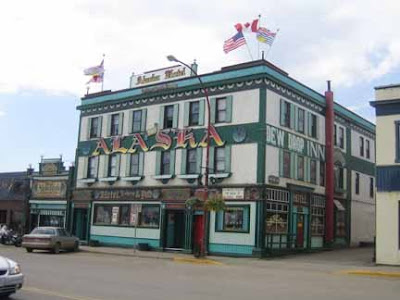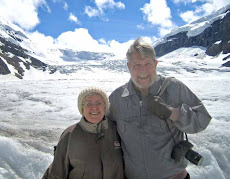 We have planned for and tried to take this Alaska trip for four years. Our being a vendor at RV shows/rallies and presenting seminars always got in the way. This year, everything fell into place with only one of the big rallies scheduled for August. So we decided to skip that one leaving the summer open and Alaska calling us. It was a go. Our friends could not join us but we decided to go anyway. You have to do this stuff while you are healthy!
We have planned for and tried to take this Alaska trip for four years. Our being a vendor at RV shows/rallies and presenting seminars always got in the way. This year, everything fell into place with only one of the big rallies scheduled for August. So we decided to skip that one leaving the summer open and Alaska calling us. It was a go. Our friends could not join us but we decided to go anyway. You have to do this stuff while you are healthy!
We spent our normal January-April time in Florida and Georgia and departed there late April and headed to Texas. There, we visited family and friends for about three weeks and departed northbound on May 17th. We followed David and Lana Greer about 300 miles to the Texas panhandle (Clarendon, near Amarillo) and stayed the night there after a tour of their ranch and to meet their cow. We continued the drive up through Denver, then Wyoming, and finally arrived in Bigfork, Montana to visit relatives. Had a great time there for about three days and then it was time for Canada. We left Bigfork on May 26th and had an easy border crossing—for a change, no one searched the coach! We were just driving up through Banff and Jasper parks and did very little stopping since we had spent about 6 weeks in that area last year. It is gorgeous country but we are headed for gorgeous country. North of Jasper was new country but not much to see so most days were in the 300-mile range. Here, we are passing a still-frozen lake!
We were just driving up through Banff and Jasper parks and did very little stopping since we had spent about 6 weeks in that area last year. It is gorgeous country but we are headed for gorgeous country. North of Jasper was new country but not much to see so most days were in the 300-mile range. Here, we are passing a still-frozen lake!
Dawson Creek, BC
We got to our first “real” on-the-way-to-Alaska city—Dawson Creek, British Columbia—also “Mile 0” of the ALCAN highway. Dawson Creek is where many of the caravans meet for the first time. The towns we go through are small and it's a long way between them. I was on one stretch of highway that had a sign warning drivers that it was 103 miles to the next services.


 The ALCAN was one of the significant accomplishments in early WWII when the US Army built the 1,500 mile road from Dawson Creek, BC to (almost) Fairbanks, Alaska in EIGHT MONTHS!!! This was an impressive accomplishment by any standard. There are many things lost in history and the significance of the ALCAN Highway project was rapidly overshadowed by other war news.
The ALCAN was one of the significant accomplishments in early WWII when the US Army built the 1,500 mile road from Dawson Creek, BC to (almost) Fairbanks, Alaska in EIGHT MONTHS!!! This was an impressive accomplishment by any standard. There are many things lost in history and the significance of the ALCAN Highway project was rapidly overshadowed by other war news.
One of the unusual aspects of the highway project is called the Kiskatinaw Bridge. It is one of the very few curved bridges in the world. There is one short section of the ALCAN Highway that is preserved in a park but you can drive it. We were just passing through this area so, we actually drove the motorhome with the car in tow over this section. It was a bit rough but we were going slow. Yes, we drove across the bridge.
The initial road was completed in September 1942 (the month/year I was born) and allowed supplies to be trucked into Alaska. During construction, the Japanese attacked the island of Attu (part of the Aleutian Islands of Alaska). This was the site of the only World War II battle on United States soil. The news of that battle spurred the construction.
There is lots of driving up here! That ALCAN is a bit shorter now (they have straightened it out in many places over the years). So when you leave Dawson Creek, BC, you are just driving. We were planning on a maximum of 300 miles daily so definitely not rushing. But it's a long trip up here!
One of the best do-not-leave-home-without-it books to have is "The Milepost." Get a new copy (it comes out about March each year). Starting at Dawson Creek (Mile "0"), The Milepost guides you along the ALCAN highway and provides information down to the tenth-of-a-mile—including every turn-out, restaurant, service station, bridge/stream/river/lake, and other stuff including an occasional beaver dam, too. You will definitely use it!
One of the problems is that there are numerous mile markers. There are Historic Markers (the original ones) and these are actually used as addresses in some locations. There are newer mile markers as a result of shortening the ALCAN about 130± miles. Then there are the kilometer markers since you are in Canada—it's their highway—part of the original deal was that we had to give the highway to them. The Milepost book will show you how to distinguish.
The Yukon Territory Like many other places on this planet, for years I have wanted to visit the Yukon [Territory] every since Sergeant Preston and his faithful dog, Yukon King, were on TV back in the 1950s. I don't think I ever saw his Canadian Mountie uniform in full color since we only had black-and-white reception on our TV then. But what the heck, we all get our incentive from somewhere!
Like many other places on this planet, for years I have wanted to visit the Yukon [Territory] every since Sergeant Preston and his faithful dog, Yukon King, were on TV back in the 1950s. I don't think I ever saw his Canadian Mountie uniform in full color since we only had black-and-white reception on our TV then. But what the heck, we all get our incentive from somewhere!
The phrase “North of 60” on the sign is referring to the 60th parallel (latitude). I find it interesting that Antarctica starts at 60° south—but when we were down there last February/March (2008), it was all ice and snow. Read about that trip here.
Visited the Sign Post Forest in Watson Lake, YT (Yukon Territory). Unusual! This started in 1942 when a couple of GIs (working on the ALCAN) put up signs to their hometown. They now have about 55,000 signs.

 Yesterday, we saw a road sign that said “Extreme dust. Gravel areas for next 60 km” It was where they were patching. The gravel was smooth but dusty. We ran all three roof ACs and it definitely helped keep the dust out (by creating a positive air pressure inside the coach). Really glad I learned that trick. Got into several 6-10 mile-long gravel stretches so dust was definitely a factor. Road was washboarding in some places so just slowed down to 25 mph or so. No major holes, just vibration. We only see another car every five miles or so. Roads are good and the ALCAN is paved all the way. Any gravel areas are the result of construction. They have such a short time to work on the roads (due to weather) that they jump right in.
Yesterday, we saw a road sign that said “Extreme dust. Gravel areas for next 60 km” It was where they were patching. The gravel was smooth but dusty. We ran all three roof ACs and it definitely helped keep the dust out (by creating a positive air pressure inside the coach). Really glad I learned that trick. Got into several 6-10 mile-long gravel stretches so dust was definitely a factor. Road was washboarding in some places so just slowed down to 25 mph or so. No major holes, just vibration. We only see another car every five miles or so. Roads are good and the ALCAN is paved all the way. Any gravel areas are the result of construction. They have such a short time to work on the roads (due to weather) that they jump right in.
Spent the night at Mukluk Annies (about 8 miles north of Teslin, YT). For $18.00, you get fresh grilled salmon (or a nice looking steak), salad bar, baked potato, beans, bread, and a brownie AND free boondocking next to the lake. What a deal! Salmon was just fine. There were about 30 rigs there for the night.
Just outside of Teslin, we passed the US 37 turnoff (Cassiar Highway) that goes south. That is our route going back—it goes to Prince Rupert where we get the ferry to Port Hardy on the north tip of Vancouver Island. So from that turnoff to Tok, AK (650 miles) is just going to be driving and not being a tourist. We will have to backtrack that 650 miles on the return trip and have plenty of time then to play tourist.
I can't use my satellite dish most places. The elevation goes to 85° and from a level coach, that's pointing the dish slightly downward!!! So any tall bush blocks the signal. Luckily, lots of these campgrounds have free WIFI.
The next night we stayed free at a restaurant parking lot in Burwash Landing. Dinner was good. It seems fairly common for businesses (restaurants IF you eat and fuel stops IF you fill up) to trade a boondock site for the night. We stopped and toured their museum (very good) and asked about boondocking. We were told to go to the restaurant at the bottom of the hill and we could park overnight if we ate dinner there. We did.
The last 100 miles of the Yukon were the poorest roads of any on the entire trip from Texas. We were warned that the frost heaves would make the highway full of ruts (oriented parallel to the highway) and frost heaves (sunken areas and tiny hills perpendicular to the highway). There were plenty of both and we encountered them immediately. It was a real test of the shocks and air bags!
The ruts were 2-3 inches deep and 6-36 inches wide running for a few foot or up to maybe 40-50 feet down the surface of the road. If you miss seeing them (allowing you to steer around it) these ruts would pull your tires/vehicle into the “groove” and you just had to fight it until the rut ended. On three occasions, my tow car started an “oscillation” back and forth and the only way to stop it was to quickly stop the coach right in the highway. Then, everything was fine again. Thankfully, there was little traffic.
You couldn't take your eyes off the road. If you missed slowing down for a frost heave, it would nearly launch the front wheels of the coach off the ground—even driving about 35-45 mph. There were small orange flags marking lots of them but hundreds had no warning. There were literally thousands of them in the 100 or so miles. Hitting these at some given speed will cause “porpoising” where the vehicle is sort of floundering up and down.











































